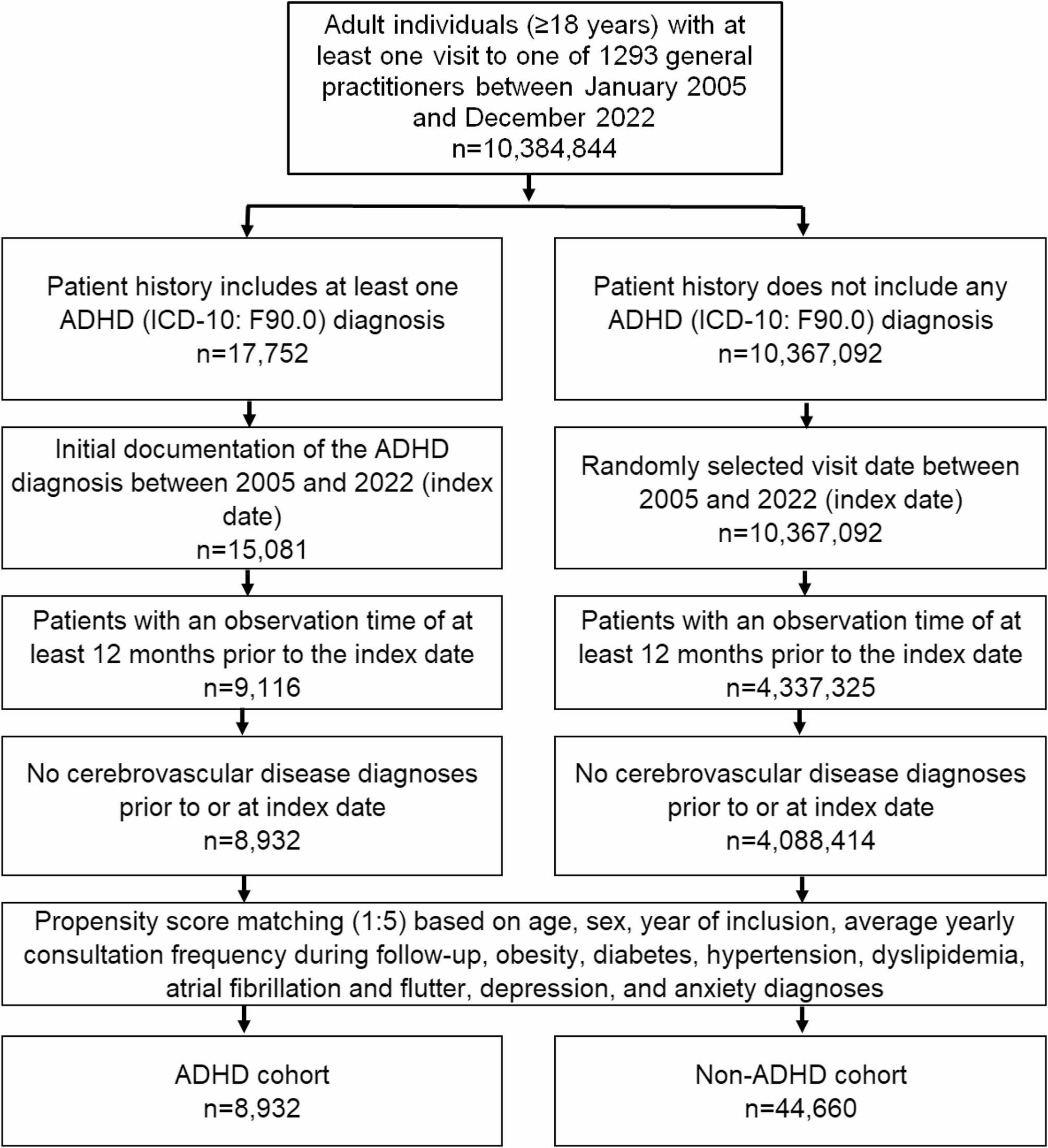This study provides novel insights into the association between ADHD and cerebrovascular disease (AIS; TIA), particularly in adults aged 45 and older with metabolic comorbidities. Our findings indicate that individuals with ADHD had a higher cumulative incidence of TIA and AIS compared to controls, with the association being particularly pronounced in those with obesity, hypertension, or dyslipidemia. These results align with prior research demonstrating an increased cardiovascular burden in ADHD patients, although most previous studies have focused on younger populations and the immediate cardiovascular effects of stimulant medication rather than cerebrovascular outcomes in adults [5, 17].
Zhang et al. recently conducted a large-scale case-control study using Swedish national registry data and reported an increased incidence of cardiovascular diseases, including cerebrovascular events, among ADHD patients with long-term stimulant use [17]. Their analysis demonstrated a 4% increase in cardiovascular disease incidence per additional year of ADHD medication use, with the greatest risk occurring within the first three years of treatment. Notably, prolonged medication exposure (> 5 years) was significantly associated with hypertension and arterial disease, both of which are established risk factors for cerebrovascular disease [17]. While these findings emphasize the importance of long-term cardiovascular monitoring in ADHD patients, the study did not fully differentiate between the direct impact of ADHD itself and the modifying role of pharmacotherapy [17]. Our results suggest that ADHD may be associated with cerebrovascular diseases, particularly in individuals with metabolic disorders; however, given the potential influence of unmeasured confounders, further research is needed to clarify the mechanisms underlying this association.
The potential biological pathways linking ADHD and cerebrovascular disease likely involve a complex interplay of metabolic dysregulation, vascular dysfunction, and behavioral factors [16, 22, 23]. ADHD has been associated with an increased prevalence of lifestyle-related risk factors, including smoking, physical inactivity, and unhealthy dietary habits [22, 23], all of which contribute to metabolic syndrome and cardiovascular disease [24]. Additionally, ADHD has been linked to autonomic dysregulation, which may influence vascular tone and hemodynamic stability, further exacerbating cerebrovascular risk [16].
Stimulant medications commonly prescribed for ADHD are known to increase blood pressure and heart rate. A meta-analysis by Mick et al. reported a mean increase of 5.7 beats per minute in resting heart rate and a 2.0 mmHg rise in systolic blood pressure among ADHD patients receiving stimulant therapy [4]. While these changes may appear modest, even slight elevations in blood pressure over time could contribute to cerebrovascular burden, particularly in individuals with pre-existing vascular risk factors [25]. However, Shin et al. found no significant association between ADHD medication and cerebrovascular disease in pediatric and adolescent populations, suggesting that vascular changes in adulthood, rather than stimulant-related effects alone, may play a more critical role in cerebrovascular outcomes [5].
The observed association between ADHD and cerebrovascular diseases appears to be amplified in individuals with metabolic disorders. Insulin resistance, chronic inflammation, and lipid dysregulation are key contributors to atherosclerosis and cerebrovascular pathology [26]. The metabolic score for insulin resistance (METS-IR) has been identified as a predictor of stroke risk in hypertensive patients, reinforcing the hypothesis that metabolic impairments may mediate cerebrovascular outcomes [26]. Although METS-IR was not specifically assessed in our study, the significant interaction between ADHD and metabolic comorbidities suggests that future investigations should explore the role of insulin resistance and lipid metabolism in ADHD-related cerebrovascular diseases.
Several limitations must be considered when interpreting the findings of this study. The reliance on ICD-10 coding means that conditions such as obesity, diabetes, and hypertension were identified based on general practice documentation rather than objective clinical measurements (e.g., BMI, laboratory values), which may have introduced misclassification. Additionally, diagnoses typically made in hospital, such as AIS and TIA, are often recorded retrospectively in general practice — only after this would the corresponding ICD-10 code appear in our dataset, potentially leading to underreporting of outcomes. The use of 1:5 propensity score matching improved comparability and statistical power but may have introduced residual differences between the groups, potentially affecting generalizability. Furthermore, information on ADHD symptom severity was not available, preventing an analysis of whether more severe ADHD cases were disproportionately associated with cerebrovascular diseases. Similarly, data on ADHD pharmacotherapy were inaccessible, as stimulant and non-stimulant medications are primarily prescribed by psychiatrists rather than general practitioners. This limitation precluded an assessment of the potential impact of ADHD treatment on cerebrovascular risk.
Additionally, key lifestyle factors (e.g., smoking status, physical activity, diet)—which are well-established contributors to cerebrovascular risk—were not available in the dataset, increasing the possibility of residual confounding. Given the retrospective observational design, causality cannot be established, and unmeasured confounders may have influenced the observed associations.
Despite these limitations, this study has several strengths. The large sample size enabled robust statistical analyses and improved generalizability. The application of propensity score matching accounted for key confounders such as age, sex, and metabolic comorbidities, enhancing the validity of comparisons between ADHD and non-ADHD individuals. The long follow-up period of up to ten years provided valuable insights into long-term cerebrovascular risks associated with ADHD, particularly in older adults and those with metabolic conditions. Furthermore, detailed subgroup analyses helped elucidate how metabolic comorbidities interact with ADHD in relation to cerebrovascular diseases.
